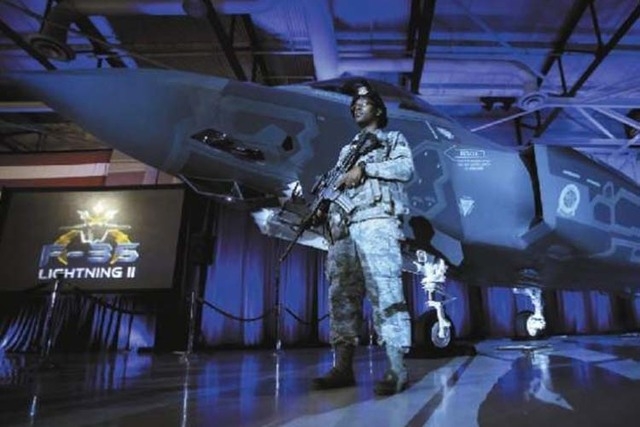F-35 fighters flying again at Nellis

F-35 Lightning II stealth fighter jets that had been grounded at Nellis Air Force Base resumed flying Friday.
Nellis spokeswoman 1st Lt. Sarah Ruckriegle said the four F-35s assigned to the 422nd Test and Evaluation Squadron were cleared to return to the skies after the nation’s fleet was grounded earlier this month following a June 23 fire in one in Florida.
While aviation buffs had their hopes dashed for seeing F-35 Joint Strike Fighter jets fly at an airshow in England this week, the latest setback that grounded the F-35s didn’t faze Red Flag pilots at Nellis who expect the high-tech, stealthy jet will someday fly in Nevada’s air combat training exercise.
But that day was pushed farther on the horizon after the fire in an F-35 at Eglin Air Force Base, Fla., grounded the fleet. The Pentagon on Monday authorized limited flying after the fire was blamed on excessive rubbing of engine fan blades and not a fundamental design flaw.
Even with the Nellis F-35s returning to the skies, it would still be premature to consider including them in any near-term Red Flag training scenarios, said Capt. David Kopp, team chief for the 414th Combat Training Squadron that’s conducting the Red Flag exercise through July 25.
In a Red Flag briefing Wednesday, he noted that while the United States has been testing F-35s for the Air Force, Navy and Marines, there are currently no operational F-35 units.
“It’s quite a ways down the road before we start thinking, ‘OK. How are we going to integrate with these guys?’” he said. “They still need to work on their tactics and procedures on how they’re going to operate.”
Nellis has four F-35 Lightning IIs but is expected to have 36 for testing and training by 2020. They are assigned to the 422nd Test and Evaluation Squadron, a tenant squadron at Nellis from the 53rd Wing in Florida.
Meanwhile, the nation’s other “fifth generation” air-superiority jet — the F-22 Raptor — achieved full operational status in December 2007 and several of them were seen Wednesday flying from Nellis. They were thundering northward with “fourth generation” F-15 and F-16 jets that were among more than 100 aircraft from the United States, France and Singapore participating in the Red Flag exercise over the Nevada Test and Training Range.
When the arrival of the first F-35s was celebrated at Nellis in March 2013, then-warfare center commander Maj. Gen. Jeffrey G. Lofgren lauded them as fitting teammates for F-22 Raptors.
“The F-22, which will provide air superiority in the battle space, combined with the F-35 is a combination with no equal,” he told hundreds of airmen and community leaders.
One F-15 pilot who spoke to aviation writers Wednesday, Capt. Tom Morrill of the 335th Fighter Squadron from Seymour Johnson Air Force Base, N.C., said Raptors are blazing the trail for integrating more advanced fifth generation aircraft with combat-proven fourth generation jets such as the Strike Eagles he flies.
“The F-22 is here and we are learning how to integrate with those guys,” Morrill said. “And those lessons learned not only from the ‘fourth gen’ perspective but those guys who transferred from the ‘fourth gen’ to the ‘fifth gen,’ those skills and experiences are going to factor in when they develop the tactics and we all fight together.”
From problems two years ago with jitter and night-vision blur in F-35 helmets, which give pilots a 360-degree view, to last month’s engine fire, the jet that is supposed to replace aging F-16 and A-10 warplanes has been plagued with glitches.
The last F-35, priced at $67 million, was flown to Nellis from Lockheed Martin’s production plant in Fort Worth, Texas, in April 2013. That F-35 had been expected to arrive a month earlier but the pilot made a precautionary landing March 11, 2013, at the Lubbock, Texas, airport for what a spokesman later described as “a wire connector issue in the flight control system.”
The F-35 was stranded in Lubbock while technicians spent weeks troubleshooting the problem in the complex, triple-redundant flight control system before tracing it to an issue with the communication system. The problem was fixed, and the plane was flown back to the plant for more testing. It finally arrived at Nellis on April 24, 2013.
The entire fleet of nearly 100 planes was grounded after the June 23 fire at Eglin Air Force Base in Florida. Initially the military declared a temporary suspension of F-35 flight operations while a safety investigation was conducted. But military leaders later halted all flights and ordered inspections of the F-35 engines to determine whether there was a systemic problem or the issue was limited to the one damaged aircraft.
The Pentagon plans to acquire 2,443 F-35s. With the latest cost estimate from Lockheed Martin at roughly $80 million apiece, some will go to at least eight partner nations: the United Kingdom, Italy, the Netherlands, Turkey, Australia, Norway, Denmark and Canada.
Contact Keith Rogers at krogers@reviewjournal.com or 702-383-0308. Find him on Twitter: @KeithRogers2.